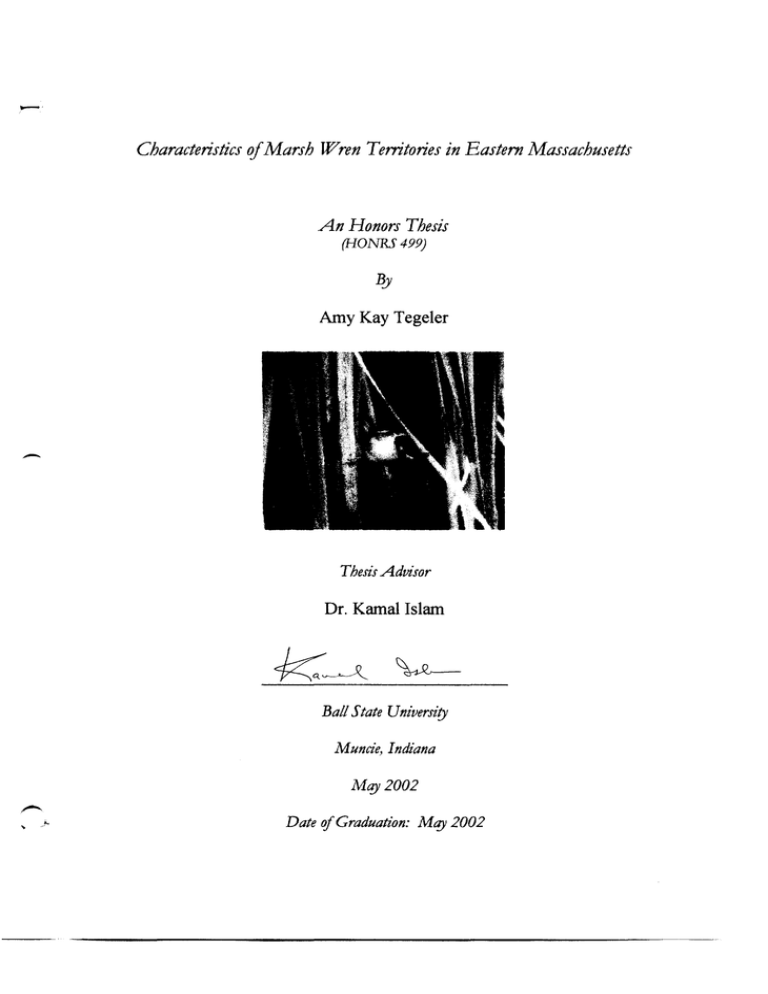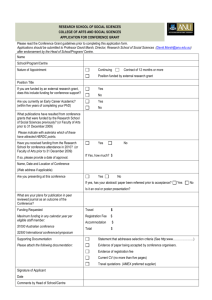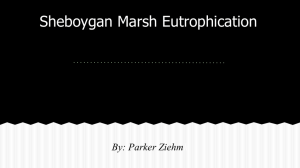- -' of oj
advertisement

-' Characteristics ojMarsh Wren Territories in Eastern Massachusetts An Honors Thesis (HONRS499) By Amy Kay Tegeler Thesis Advisor Dr. Kamal Islam Ball State Universiry Muncie, Indiana May 2002 Date of Graduation: Mt!} 2002 - ABSTRACT Marsh Wren (Cistothorus palustris) populations in the eastern United States have been declining. One of the main causes for these declining trends is the destruction of wetlands for development and agriculture. Restored and re-created wetlands help reestablish Marsh Wren populations. To examine habitat components selected by Marsh Wrens, vegetation and water parameters were measured at two locations at Great Meadows National Wildlife Refuge (GMNWR), Sudbury, MA during summer 2001. Marsh Wren territories were determined using behavioral observations and playback of tape recordings. Vegetation plots were used to compare several parameters between territories and random sites. These two study locations varied greatly; thus, they were treated separately for data analyses. At Wash Brook, territorial sites had significantly _ greater cattail (Typha spp.) density and height than random sites. At Concord, purple loosestrife (Lythrum salicaria) was less dense at territories than random sites; Wash Brook did not contain purple loosestrife. Water depth was significantly lower at Wash Brook territories, and significantly higher at Concord territories suggesting that it was not a factor determining Marsh Wren territories. My data also suggests that tall, dense, vegetation structure is selected by Marsh Wrens with cattail as the selected species. Furthermore, Marsh Wrens avoided habitats with purple loosestrife, an invasive species. However, further studies are needed to determine if habitat parameters other than the ones I measured are important components of Marsh Wren territories. - INTRODUCTION Marsh Wrens (Cistothorus palustris) have a breeding range extending from Minnesota south to northern Missouri and east through Maine. They are fairly common 2 in the eastern half of Massachusetts (Veit and Peterson 1993). They also occur in southern California east to the Colorado River valley. Within its range, Marsh Wrens are restricted to freshwater and saltwater marshes, which can be geographically and annually unpredictable (Kroodsma and Verner 1997). Freshwater Marsh Wren territories have been known to contain cattail (Typha spp) and bulrush (Scirpus spp). Verner and Engelsen (1970) suggested that cattails were the preferred nesting cover over bulrush. Others have suggested that female Marsh Wrens use habitat characteristics, rather than male quality, when selecting nesting areas (Leonard and Picman 1987). Marsh Wren populations have declined in many parts of its distribution. In several states it is listed as a " species of special concern" or "vulnerable species". The - Marsh Wren is listed as a "vulnerable species" in Pennsylvania (Brauning 1992) and is a "species of special concern" in Florida (Stevenson and Anderson 1994). Marsh Wren populations in the northeastern United States have declined at a rate of5.9% from 1966 to 1994 based on Breeding Bird Survey data. In addition, populations from the north central United States to the northeast corner of Oklahoma have declined 11.5% (Kroodsma and Verner 1997). These downward trends in the eastern population of the Marsh Wren could be significant if it is listed as a separate species from the western form. Researchers have found that two evolutionary groups, eastern and western, exist in North America. In the western group, males have a variable and complex song; their songs use harsh, grating sounds and are often coupled with loud tonal notes. Eastern males lack the harshness exhibited by their western counterparts (Kroodsma and Verner 1997, Kroodsma 1986). Genetically, eastern male singers choose to mate with eastern females, and western male singers choose to mate with western females. Marsh Wrens 3 clearly do not mate at random, and therefore, warrant possible separate species status (Kroodsma and Verner 1997). One of the main causes for these declining trends is the destruction of marshes throughout the Marsh Wrens' range. Marsh Wrens were once abundant in Michigan, but several marshes have been filled or drained causing a significant decline in Marsh Wren populations (Brewer et al. 1991). Before South Cape May Meadows in New Jersey was drained, migrant and breeding populations of Marsh Wrens were much larger (Sibley 1993). Most studies have documented rapid loss of wetlands in the United States, at least prior to the mid-1970's (Mitsch and Gosselink 1986). However, many states now recognize the value of these endangered wetlands, and the concomitant loss of biodiversity. In response, several states are in the process of restoring and re-creating - wetlands (Mitsch and Gosselink 1986). In places where marshes have been restored or created, Marsh Wren populations have responded positively. After a dam was built along the Colorado River resulting in the creation of a marsh, Marsh Wren populations increased in number (Rosenberg et al. 1991). Few studies have examined the breeding habitats of Marsh Wrens in natural wetlands. This information is needed so that we can use models of natural wetlands to re-create artificial wetlands and use them as part of habitat restoration for Marsh Wrens. STUDY AREA AND METHODS Great Meadows National Wildlife Refuge (GMNWR), 37 km northwest of Boston, provides an excellent opportunity to study Marsh Wren in its natural habitat (Figure 1). GMNWR encompasses 1462 ha, and includes 19 km of the Concord and Sudbury Rivers which provide freshwater wetlands for Marsh Wrens and other wetland 4 Great Meadows National Wildlife Refuge Concord/Sudbury Units N ... o 1.5 3 Miles Concord impoundments Wash Brook - FlO. 1. .Location of Wash Brook and Concord impoundments, Oreat Meadows National Wildlife Refuge. Massachusetts, 2001. _ Concord Unit _ Sudbury Unit ~ Concord/Sudbury River 5 birds. Marsh Wren populations have been recorded at GMNWR for the past ten years. During the spring and summer they are a common nesting species on the refuge (USFWS 2000). Territory Surveys Bird surveys were conducted at GMNWR from 1 June-I July 2001. Dominant vegetation at Wash Brook consisted of cattail and canary reed (Phalaris arundinacea). Concord impoundments consisted of two wetlands separated by a gravel dike. Each wetland edge had vegetation that was dominated by cattail and purple loosestrife (Lythrum salicaria). Territories were defined as any area defended by a Marsh Wren. Territory __ boundaries were determined by playing a recorded territorial Marsh Wren song while walking along the outside boundary of the marsh, and walking or canoeing along the waterside of the marsh edge. Playback of territorial songs attract conspecific male Marsh Wrens to the edge of their territory boundaries (Verner and Engelson 1970). Territory boundaries were determined when a male ignored the tape recordings of conspecifics and flew away. Behavioral observations were also recorded and spot mapped to help verify territory boundaries. A minimum of five points (range = 5-9) were used to determine each territory size. Point locations were recorded using a global positioning system (OPS) unit. Territory sizes were calculated using the minimum convex polygon method. A playback to one male may affect surrounding males (Kroodsma 1986). To reduce the stress level of surrounding males resulting from tape recording playbacks, tests on adjacent males were not conducted on the same day. 6 - Random Sites Average territory size was used to detennine size of random sites. Random sites were areas not defended by Marsh Wrens and were located within the same wetlands as Marsh Wren territories to reduce the affects of variables not being tested in this study. Marsh Wren territorial songs were played along the wetland edge in the same manner as the territorial sites. Areas without any evidence of Marsh Wrens were used as random sites. Random sites were located from 1 -15 July 2001. Five points were used to find the area of each random site using the same method as the territorial sites and these point locations were recorded using a GPS unit. Vegetation Sampling - Vegetation measurements were taken from 15 - 30 July 2001. Five 1 m 2 plots were placed within each territory and random site. One plot was placed in the center of each site. Another plot was placed 33 m from the center plot in each cardinal direction. Within each plot, all species of vegetation were identified to at least the genus level (Table 1). Vegetation parameters measured for each species were average height (em) and density (# stems/m2 ). Average height of each species located within each plot was measured by grasping all stems of a species and pulling them to the center of the plot. Average height of each species was detennined by measuring the height of the bundle using a graduated stick. Vegetation was measured from the surface of the water to the top of the tallest piece of vegetation. Species density was detennined by counting the number of stems of each species rooted within the plot. Density was not detennined for .~ any grass species (Poaceae). 7 TABLE l. Plant species recorded at Marsh Wren territories and random sites at Wash Brook and Concord impoundments, Great Meadows National Wildlife Refuge, Massachusetts, 2001. Species Wash Brook Territories Random American Lotus (Nelumbo lutea) Arrow Arum (Peltandra virginica) Blue-Joint (Calamagrostis canadensis) Bur Reed (Sparganium androcladum) Button Bush (Cephalanthus occidentalis) + Canary Reed (Phalaris arundinacea) + Cattail (Typha spp) + Common Ragweed (Ambrosia artemisiifolia) -Dodder (Cuscuta gronovii) Duckweed (Lemma spp) False Nettle (Boehmeria cylinderia) Giant Bur Reed (Sparangium eurycarpum) Jewel Weed (Impatiens capensis) Pickerel (Pontederia cordata) Purple Loosestrife (Lythrum salicaria) Smart Weed (Polygonum lapathifolium) Sugar Maple (Acer saccarum) Swamp Rose (Rosa palustris) Tussock Sedge (Carex stricta) -- = Species absent + = Species present in at least one plot + + + + + + + + + + Concord Territories Random + + + + + + + + + + + + + + + + + + + + + + + + + 8 Abiotic Measurements Water depth (cm) was measured within each plot at territorial and random sites by placing a graduated stick in the center of each plot. Water column depth was measured from the bottom of the marsh to where the graduated stick broke the surface of the water. Data Analyses Discriminant Function Analysis (Sharma 1996) was used to determine if Wash Brook and Concord locations could be grouped together for data analyses. Student's ttests (Snedecor and Cochran 1980) were used to determine if significant differences existed in species average height, species density, and water depth between random and territorial sites (level of significance = 0.05). RESULTS Discriminant Function Analysis was performed to determine if the two study locations, Concord and Wash Brook, were similar in biotic and abiotic characteristics. Nineteen variables (Table 2) were entered into the Discriminant Function Analysis. The following four variables accounted for 85% of the variation between the two locations: canary reed height, canary reed percent cover, cattail height, and purple loosestrife density. At Wash Brook, 91% of the data were correctly classified as territorial sites, and 89% of the data were correctly classified as random sites. At Concord, 86% of the data were correctly classified as territorial sites and 67% of the data were correctly classified as random sites. Based on this analysis, Wash Brook and Concord were treated separately. 9 TABLE 2. Variables entered into the Discriminant Function Analysis, Great Meadows National Wildlife Refuge, Massachusetts, 2001. Variable - Wilks' Lambda Ground % Cover Water % Cover Water Depth (em) Canary Reed % Cover Live Canary Reed % Cover Dead Canary Reed Height Live (cm) Canary Reed Height Dead (cm) Cattail % Cover Live Cattail % Cover Dead Cattail Density Live (# Stems) Cattail Density Dead (# Stems) Cattail Height Live (cm) Cattail Height Dead (em) Purple Loosestrife % Cover Live Purple Loosestrife % Cover Dead Purple Loosestrife Density Live (# Stems) Purple Loosestrife Density Dead (# Stems) Purple Loosestrife Height Live (em) Purple Loosestrife Height Dead (em) 0.660 0.525 0.623 0.068 a 0.026 a 0.290 0.541 0.253 0.488 0.347 0.570 0.624 0.843 0.544 0.858 0.502 0.823 a. Cannot be computed because this variable is a constant. dfl df2 Sig. 3 3 3 3 29 29 29 29 0.007 0.000 0.003 0.000 356.618 3 29 0.000 3 3 3 3 3 3 3 3 3 3 3 3 29 29 29 29 29 29 29 29 29 29 29 29 0.000 0.000 0.000 0.000 0.000 0.001 0.003 0.169 0.000 0.212 0.000 0.125 F 4.982 8.744 5.847 132.549 23.710 8.202 28.466 10.139 18.230 7.306 5.824 1.802 8.113 1.596 9.573 2.079 10 Territorial and Random Sites Eleven Marsh Wren territories were located at Wash Brook and 7 territories were located at Concord impoundments (mean = 0.41 ha; range = 0.1-1.5 ha). Nine random sites were located at Wash Brook and 6 random sites were located at Concord impoundments each 0.41 ha in size. The number of random sites did not equal the number of territories because in each study location, areas not utilized by Marsh Wrens were less than areas occupied by Marsh Wrens. Vegetation and Abiotic Parameters The two study locations differed significantly according to the vegetation parameters measured (Table 2). Cattail and canary reed grass were the dominant species - at Wash Brook. Dominant vegetation at Concord impoundments were cattail and purple loosestrife. Within each study location, vegetation parameters differed between random and territorial sites. At Wash Brook, cattail density was greater at territorial sites than random sites (df= 10, t = 2.948, P = 0.015, Fig. 2, Table 3). Mean cattail density at territorial sites was 3.1 stems/m whereas, mean cattail density at random sites was 1.8 stems/m2 . Cattail 2 height was also greater at territorial sites than random sites (df= 10, t = 5.200, P < 0.001, Fig. 3, Table 3). Mean cattail height ofterritorial sites at Wash Brook was 137.2 cm compared to 33.7 cm at random sites. Water depth was also different between territorial and random sites. Territorial sites had lower water depth than random sites (df= 10, t = -7.628, P < 0.001, Fig. 4, Table 3). Mean water depth at territorial sites was 2.7 cm compared to 9.6 cm at random sites. 11 TABLE 3. Comparisons of vegetation and abiotic parameters between territorial and random sites at Wash Brook using Student's t-tests, Great Meadows National Wildlife Refuge, Massachusetts, 2001. Variable df Water Depth 10 Canary Reed Height 10 Cattail Height 10 Cattail Density 10 Sig. 95% Confidence Interval of the Difference Mean Difference Lower Upper <0.0001 0.825 <0.0001 0.015 -0.7329 -0.0077 3.0707 0.6970 -0.9470 -0.0840 1.7549 0.1701 -0.5188 0.0685 4.3865 1.2238 12 3.5 - - - - - - - - - - - - - - - - - - - - - - - - - - . . . . , 3 ~N- 2.5 ~ .§ en C E CI) - 2 £I ~ 1.5 ~ ~ 1 0.5 0+----- Random Territorial Wash Brook FIG. 2. Mean cattail density at Marsh Wren territories versus random sites at Wash Brook, Great Meadows National Wildlife Refuge, Massachusetts, 2001. 13 ~----- .. ---------~-- -------------------------------------------------------------- Average Cattail Height I I 140 I I ! I ~ I ~ :~ I u~ 120 100 40 20 0+-----Territorial Random Wash Brook FIG. 3. Mean cattail height at Marsh Wren territories versus random sites at Wash Brook, Great Meadows National Wildlife Refuge, Massachusetts, 2001. 14 ,-----------.----.. - ..-.. .------.--.-.------.. .--.-......···-.. ! Average Water Depth -·-··--·-·-~-~·-··-- . ·-·-....·. ---·-·-·-l ! I I ! 12 I ! 1 t 1n .; .......... ; E ~ .c Q. CI> C ... f I S ~ - \ , R-i l 6 4 2 .............. -' .........,.................. ..... ," ~-.-.- Random Territorial Wash Brook FIG. 4. Mean water depth at Marsh Wren territories versus random sites at Wash Brook, Great Meadows National Wildlife Refuge, Massachusetts, 2001. 15 Territorial sites at Concord impoundments had lower purple loosestrife density than random sites (df= 6, t = -7.861, P < 0.001, Fig. 5, Table 4). Mean purple loosestrife density at territorial sites was 0.8 stemslm2 whereas, mean purple loosestrife density at random sites was 4.0 stems/m2. Water depth was also different between territorial and random sites at Concord impoundments (df= 6, t = 2.443, P = 0.05, Fig. 6, Table 4). Mean water depth at territorial sites was 19.8 cm, while at random sites, the mean was 7.8 em. DISCUSSION At Wash Brook, Marsh Wrens selected areas with greater amounts of cattail than random sites. Marsh Wrens are known to use cattail as nesting material and also as nest supports (Verner 1965, Verner and Engelsen 1970). It has been suggested that tall, dense vegetation and deep water might protect nests from mammalian predators (Leonard and Picman 1987). My results from Concord supports this hypothesis as Marsh Wrens selected areas with deeper water. At Wash Brook, Marsh Wrens also selected areas with greater cattail density and height, but territories had shallower water depths than random sites, and most territories lacked standing water. This suggests that the benefits of standing water were outweighed by other factors. Wash Brook had dense canary reed at both territorial and random sites. Although no correlation was calculated between water depth and canary reed density, dense stands of canary reed possibly provide concealment for nests. Canary reed was used as nesting material and nest support at Wash Brook even though cattail was available within the territories. More research is needed to determine the exact role that canary reed grass plays in Marsh Wren territories. 16 TABLE 4. Comparisons of vegetation and abiotic parameters between territorial and random sites at Concord impoundments using Student's t-tests, Great Meadows National Wildlife Refuge, Massachusetts, 2001. Variable df Sig. 95% Confidence Interval of the Difference Upper Mean Difference Lower Water Depth Cattail Density Cattail Height Purple Loosestrife Density Purple Loosestrife Height 6 6 0.050 0.563 0.538 1.5484 0.1597 0.0333 -0.0022 -0.4783 -0.0913 3.0990 0.7976 0.1579 6 <0.0001 -0.8052 -1.0558 -0.5546 6 0.077 -0.4751 -1.0200 0.0697 6 17 l Average Purple Loosestrife Density 4 t/J ; 3.5 e_ - el) N ~ u;... eI) E ~ 2.5 o~'.f!! en .3 ~ - c. 5 0.. 3 :!. 2 1.5 1 0.5 0+-----' Territorial Random Concord L -_ _ _ _ _ _ _ _ _ _ _ _ _ _ _ _ _ _ _ _ _ _ _ _ _ _ _ _ _ _ _ o_ _ _ _ FIG. 5. Mean purple loosestrife density at Marsh Wren territories versus random sites at Concord, Great Meadows National Wildlife Refuge, Massachusetts, 2001. J 18 I Average Water Depth 25 II I _ 20 E ! -C) s::. 15 Q. Q) C -~ Q) - ~ 10 5 0 Territorial Random Concord FIG. 6. Mean water depth at Marsh Wren territories versus random sites at Concord, Great Meadows National Wildlife Refuge, Massachusetts, 2001. 19 Purple loosestrife, present at the Concord location, was another species that seemed to influence the establishment of Marsh Wren territories. Whitt et al. (1999) noted that Marsh Wren abundance was lower in purple loosestrife dominated vegetation than in other vegetation types. Marsh Wren populations in the Concord impoundments support these observations as they seemed to select areas with less purple loosestrife density than random sites. Whitt et al. (1999) also noted that Marsh Wrens preferred to nest in cattails rather than purple loosestrife. Because purple loosestrife is an invasive species commonly associated with cattail and canary reed, it should be of concern when managing wetlands that could be used as Marsh Wren habitat. Marsh Wrens could be significantly disadvantaged if purple loosestrife displaces the preferred vegetative forms (Whitt et al. 1999). ACKNOWLEDGEMENTS Many thanks are due to Dr. Kamal Islam, my thesis advisor, for his constant willingness to help as well as his never-ending optimism. He challenged me throughout this rigorous process to always do my best. Without his knowledge and support this thesis would not have been possible. I also thank Great Meadows National Wildlife Refuge for allowing me to conduct my research on their property. The research was supported through an Honors Fellowship Grant provided by Ball State University, Muncie, IN. 20 LITERATURE CITED BRAUNING, D. W. 1992. Atlas of breeding birds in Pennsylvania. Univ. of Pittsburgh Press, P A. BREWER, R, G. A. MCPEEK, AND 1. R 1. ADAMS. 1991. The atlas of breeding birds of Michigan. Michigan State Univ. Press, East Lansing. KROODSMA, D. E. 1986. Design of Song Playback Experiments. Auk 103:640-642. KROODSMA, D. E., AND 1. VERNER 1997. Marsh Wren (Cistothorus palustris). In The Birds of North America, No. 308. (A. Poole and F. Gill, eds.). The Academy of Natural Sciences, Philadelphia, Pennsylvania, and The American Ornithologists' Union, Washington, D.C. LEONARD, M. L., AND 1. PICMAN. 1987. Nesting mortality and habitat selection by Marsh Wrens. Auk 104:491-495. MITSCH, W. J., AND 1. G. Gosselink. 1986. Wetlands. Van Norstrand Reinhold Co, New York. - ROSENBERG, K. v., RD. OHMART, W. C. HUNTE, AND B. W. ANDERSON. 1991. Birds of the lower Colorado River Valley. Univ. of Arizona Press, Tucson. SHARMA, S. 1996. Applied Multivariate Techniques. John Wiley & Sons, Inc., New York. SIBLEY, D. 1993. The Birds of Cape May. New Jersey Audubon Society, Cape May Bird Point, NJ. SNEDECOR, G. W., AND W. G. COCHRAN. 1980. Statistical Methods. Iowa State Univ., Ames. STEVENSON, H. M., AND B. H. ANDERSON. 1994. The Birdlife of Florida. Univ. of Florida, Gainesville. UNITED STATES FISH AND WILDLIFE SERVICE. 2000. Great Meadows National Wildlife Refuge. U.S. Department of the Interior. U.S. Fish and Wildlife Service. VEIT, R. R., AND W. R PETERSON. 1993. Birds of Massachusetts. Massachusetts Audubon Society. VERNER, J. 1965. Breeding Biology of Marsh Wrens. Condor 67:6-30. _ VERNER, 1., AND G. H. ENGEL SEN. 1970. Territories, multiple nest building, and polygyny in the long-billed marsh wren. Auk 87:557-567. 21 ,r.. WHITT, M. B., H. H. PRINCE, AND R. R.COX, JR. 1999. Avian use of Purple Loosestrife Dominated Habitat Relative to other Vegetation Types in a Lake Huron Wetland Complex. Wilson Bulletin Ill: 105-114.




